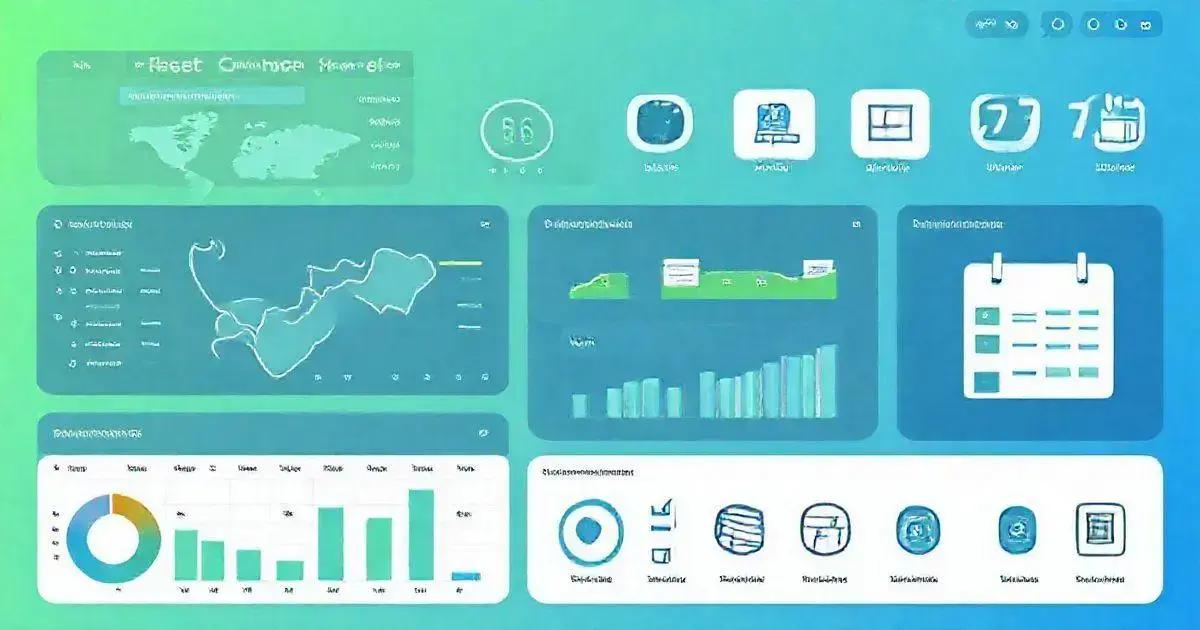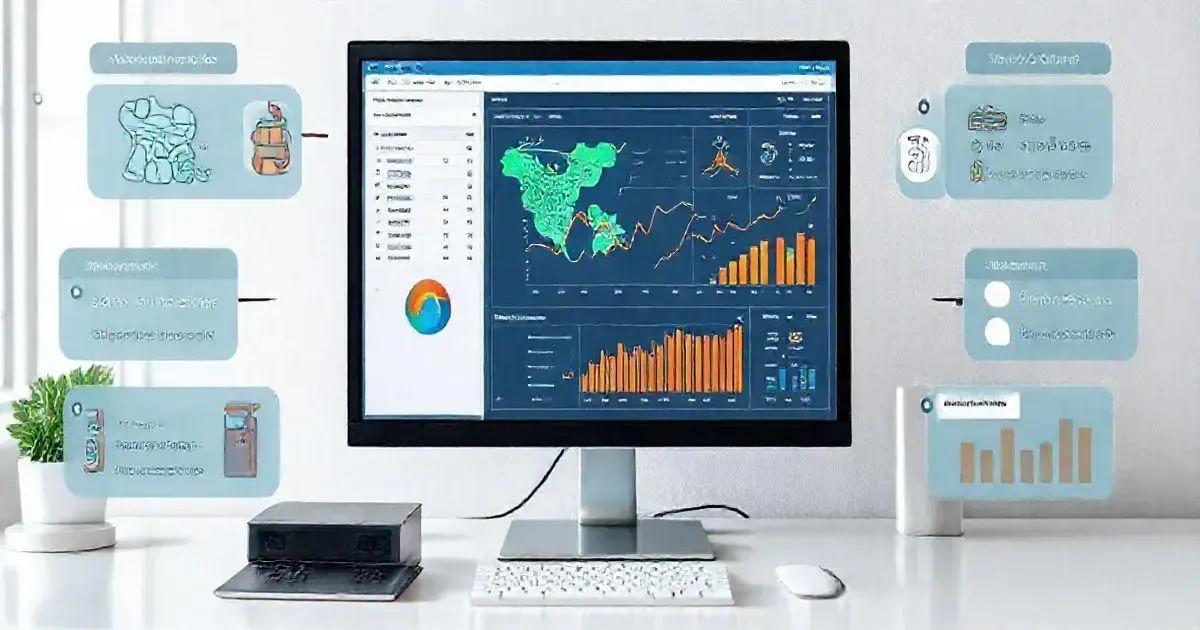5 Key Features of Fleet Control Worksheet 7.0 Leave a comment
The Fleet Control Worksheet 7.0 is an advanced management tool for fleet managers, designed to improve operational efficiency through features like dashboards for tracking kilometers driven, fuel consumption, and maintenance costs. It includes a registration management system for detailed driver and vehicle records, document management for organized paperwork, and travel control for streamlined trip management. Additionally, it offers maintenance tracking for scheduled and corrective actions, enabling informed, data-driven decisions for successful fleet operations.
The Fleet Control Worksheet 7.0 is an essential tool for anyone involved in fleet management. With its user-friendly design and comprehensive features, it helps streamline operations effectively. Let’s delve into its five key features that make it indispensable for fleet managers.
Initial Dashboards
The Fleet Control Worksheet 7.0 provides several initial dashboards that help fleet managers quickly visualize key metrics and performance indicators. Here’s a breakdown of what each dashboard offers:
- KM by Driver: This dashboard tracks the total kilometers driven by each driver, enabling you to assess their performance and usage of company vehicles.
- KM per Vehicle: Similar to the driver metric, this dashboard gives insights into how much each vehicle is being utilized, helping identify inactive or underutilized assets.
- KM per Liter: This feature calculates fuel efficiency by monitoring the distance traveled per liter of fuel, which is crucial for cost management and environmental impact assessment.
- KM per Trip: This dashboard tracks the average distance for each trip, allowing managers to optimize routes and scheduling.
- Average Consumption per Vehicle: This metric shows how much fuel each vehicle consumes on average, giving insights into potential maintenance needs or inefficiencies.
- Average Consumption per Driver: This dashboard helps identify which drivers may be using more fuel than average, prompting further training or monitoring.
- Total General Maintenance: It summarizes the total preventive and corrective maintenance tasks performed across the fleet, helping maintain vehicle longevity.
- Maintenance Cost Average: This provides insights into how much, on average, each vehicle costs in maintenance over a specified period.
- Total Cost of Mechanical and Electrical Maintenance: A comprehensive overview of all mechanical and electrical repairs, allowing for better budget planning.
- Total Tire Maintenance Cost: Tracking the costs associated with tire management helps to understand lifecycle costs of tires and informs replacement strategies.
- Total Lubricant Cost: Similar tracking for lubricants ensures you maintain optimal vehicle performance.
- Average Cost of Mechanical and Electrical Maintenance: Helps managers understand the routine expenses associated with maintaining the fleet.
- Average Tire Maintenance Cost: Assesses average spending on tire upkeep, ensuring it remains within budget.
- Vehicles in Transit: A real-time view of which vehicles are currently on the road, providing valuable information for dispatch and customer service.
- Tires in Transit: Similar to vehicle tracking, this helps ensure tire inventory is managed effectively.
- Delayed Vehicle Documents: Keeps track of any outstanding paperwork for vehicles, which is critical for compliance and legal reasons.
- Delayed Driver Documents: Ensures all driver documentation is up to date to avoid legal complications.
- Delayed Preventive Maintenance: Monitoring for overdue maintenance tasks ensures that all vehicles are serviced on time, maintaining safety and reliability.
- Total Cost Versus Shipping: A dashboard that compares overall fleet costs against shipping/transportation revenue, enabling better financial analysis.
- Fuel, Maintenance, and Other Costs: This aggregate view allows fleet managers to understand total operational costs, making it easier to identify areas for improvement.
By utilizing these dashboards, fleet managers can enhance decision-making processes, improve operational efficiency, and ultimately reduce costs across their fleet operations.

Registration Management
The Fleet Control Worksheet 7.0 offers robust features for managing registration data essential for both drivers and vehicles. This aspect of the worksheet is crucial for maintaining compliance, ensuring safety, and enhancing operational efficiency. Here’s a closer look at the key components of the registration management system:
Registration Management
- Driver Registration: This section allows fleet managers to input and maintain detailed records for each driver, including personal information, license details, and contact information. Keeping this data updated is vital for ensuring that all drivers are legally eligible to operate fleet vehicles.
- Vehicle Type Registration: Managers can register different types of vehicles within the fleet, categorizing them by type, model, and capacity. This helps in organizing the fleet efficiently and makes it easier to assign vehicles based on specific operational needs.
- Mechanical and Electrical Services Registry: This feature tracks all mechanical and electrical services performed on each vehicle. Documentation of these services aids in identifying recurring issues and planning future maintenance.
- Tree Service Registration: Allows for the logging of services related to tree maintenance that may be required for fleet vehicles used in landscaping or similar industries, ensuring operational readiness.
- Lubricant Services Register: This section records all lubricant services performed on vehicles, ensuring that maintenance schedules are adhered to and helping to prolong vehicle lifespan.
- Register of Workshops and Suppliers: Fleet managers can maintain a list of trusted workshops and suppliers for various services, including repairs, parts, and maintenance. This simplifies the process of choosing service providers for fleet needs.
- Expenditure Type Register: This feature categorizes all expenditures related to the fleet, making it easier to track and manage budgets effectively.
- Refueling Station Registration: A log of preferred refueling stations can help drivers quickly find available fuel sources, ensuring efficiency during operations.
- Fuel Type Register: This section allows managers to document different types of fuel used by the fleet, ensuring compliance with operational standards and potentially reducing costs by optimizing fuel usage.
By utilizing the registration management features in the Fleet Control Worksheet 7.0, fleet managers can maintain meticulous records that enhance compliance, facilitate better decision-making, and ultimately improve the overall management of fleet operations.
Document Management
The Fleet Control Worksheet 7.0 includes a comprehensive document management system that ensures all necessary paperwork for vehicles and drivers is organized and easily accessible. Effective document management is essential for compliance, safety, and efficient fleet operations. Here are the key components:
Key Components
- Driver Document Control: This feature allows fleet managers to track and manage all documents related to drivers, including licenses, certifications, and training records. Keeping this information up to date is crucial for ensuring that all drivers are compliant with regulations and safety standards.
- Vehicle Document Control: Fleet managers can maintain a record of all essential vehicle documentation, such as registration papers, insurance certificates, and inspection reports. This helps ensure that all vehicles are compliant with legal requirements, reducing the risk of penalties or legal issues.
Efficient document management simplifies the audit process, facilitates compliance checks, and enhances overall fleet management efficiency. With the Fleet Control Worksheet 7.0, fleet managers can ensure that all drivers and vehicles are properly documented, leading to smoother operations and improved accountability.

Travel Control Features
The Fleet Control Worksheet 7.0 incorporates advanced travel control features designed to streamline fleet operations and enhance the management of trips, cargo, and associated expenses. These features are essential for optimizing performance and ensuring that all travel-related activities are well-documented and managed. Here’s a closer look at the key components:
Travel Control Features
- Cargo Control Linked to Trips: This feature allows fleet managers to link cargo details directly to specific trips. By tracking what cargo is being transported on each journey, managers can enhance accountability and ensure that all shipments are properly documented.
- Vehicle Control: Fleet managers can monitor which vehicles are assigned to particular trips, enabling better resource allocation and ensuring that each vehicle is used efficiently. This feature also assists in tracking vehicle availability and usage patterns.
- Driver Control: This section tracks which drivers are assigned to each trip, facilitating better management of driver schedules and ensuring compliance with driving regulations and hours of service.
- Supply Control: Fleet managers can manage and document the supplies needed for each trip, including fuel, food, and other essentials. This ensures that drivers are well-equipped for their journeys and can help in budgeting for trips.
- Control of All Travel Expenses: This feature allows for comprehensive tracking of all expenses associated with each trip, including fuel costs, tolls, maintenance, and other travel-related expenses. By consolidating this data, fleet managers can better assess the overall cost of travel and identify areas for potential savings.
By effectively utilizing the travel control features in the Fleet Control Worksheet 7.0, fleet managers can enhance operational efficiency, reduce costs, and improve accountability throughout their fleet operations. This leads to more informed decision-making and streamlined management of travel resources.
Maintenance Control Systems
The Fleet Control Worksheet 7.0 includes robust maintenance control systems that are vital for keeping vehicles in optimal running condition. Efficient maintenance not only prolongs the lifespan of the fleet but also ensures safety and reliability for drivers and cargo. Here’s a breakdown of the key components:
Maintenance Control Systems
- Corrective and Preventive Maintenance Types: This system categorizes maintenance tasks into corrective (repairs after issues arise) and preventive (scheduled services to prevent issues). By tracking both types, managers can ensure that vehicles receive timely services, reducing the risk of unexpected breakdowns.
- Maintenance by Vehicle: Fleet managers can monitor maintenance schedules and histories for each vehicle individually. This personalized tracking helps identify patterns or recurring issues that may require further attention.
- Maintenance by Mechanical and Electrical Types, Tire and Lubricants: This feature allows for detailed logging of all types of maintenance performed, including mechanical repairs, electrical work, tire changes, and lubrication services. This comprehensive view ensures that every aspect of vehicle maintenance is accounted for and scheduled appropriately.
- Maintenance Cost: Managers can track the costs associated with maintenance activities, helping to budget more effectively and identify any vehicles that may be costing more than expected. This financial oversight can lead to better resource allocation and maintenance strategies.
- Preventive Maintenance Schedule: The worksheet includes a built-in scheduler for preventive maintenance tasks, which can help in planning upcoming services and ensuring that no vehicle is overlooked. This proactive approach minimizes downtime and keeps the fleet operating smoothly.
- Preventive Maintenance Signal: This feature provides alerts or signals for when preventive maintenance tasks are due, helping fleet managers stay ahead of necessary services and ensuring compliance with maintenance schedules.
- Status by: Scheduled, Accomplished, and Delayed: This tracking system allows managers to categorize maintenance tasks based on their status, giving a clear overview of what has been completed, what is upcoming, and what has been delayed. This transparency helps in planning and prioritizing maintenance needs.
By implementing these maintenance control systems in the Fleet Control Worksheet 7.0, fleet managers can enhance operational efficiency, ensure vehicle safety, and reduce long-term costs associated with fleet management. Proactive maintenance management ultimately leads to a more reliable and effective fleet.
Conclusion
The Fleet Control Worksheet 7.0 stands out as an essential tool for fleet managers looking to streamline operations and enhance overall efficiency.
With its comprehensive features ranging from initial dashboards to robust maintenance control systems, this worksheet not only simplifies the management of vehicles and drivers but also ensures compliance and safety across the fleet.
By effectively utilizing the travel control features and the document management system, fleet managers can maintain accurate records, monitor expenses, and optimize resource allocation.
Overall, the Fleet Control Worksheet 7.0 provides a holistic approach to fleet management, empowering professionals to make informed decisions that drive operational success.
Investing in the right tools, like the Fleet Control Worksheet 7.0, is crucial for any organization that relies on fleet operations.
It ensures that every aspect of fleet management is accounted for, leading to enhanced performance, reduced costs, and a more reliable service delivery.
FAQ – Frequently Asked Questions about Fleet Control Worksheet 7.0
What features does the Fleet Control Worksheet 7.0 offer?
The Fleet Control Worksheet 7.0 offers features including initial dashboards for tracking metrics, registration management for drivers and vehicles, document management, travel control, and maintenance control systems.
How does the document management system work?
The document management system allows fleet managers to track and maintain all necessary paperwork for drivers and vehicles, including licenses, registrations, and inspection reports.
Can I customize the maintenance schedules in the worksheet?
Yes, the Fleet Control Worksheet 7.0 allows you to customize maintenance schedules and set alerts for preventive maintenance tasks.
Is the worksheet compatible with different versions of Excel?
Yes, the Fleet Control Worksheet 7.0 works on multiple versions of Excel, including 2007, 2010, 2013, and 2016.
Does the worksheet help in tracking travel expenses?
Absolutely! It provides features for comprehensive tracking of all expenses associated with each trip, facilitating better budgeting and cost management.
How can I get support if I encounter issues with the worksheet?
Support is available via email or WhatsApp during business hours, and assistance is provided free of charge for any technical issues.

